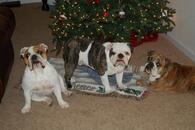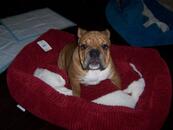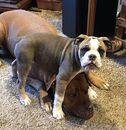blitz
New member
- Apr 19, 2015
- 41
- 1
- Country
- Canada
- Bulldog(s) Names
- chuck
My chuck was originally on alpo when we got him.. Then we switched to holistic lamb, which after 3 days he stopped eating & was lathargic,, then the vet put him on royal can in gastrointestinal which he enjoyed but started losing hair, in little spots but nonetheless losing hair.. We now have him half & half the canin & wholesomeblend.. His hair has improved greatly!! Eventually we will have him on the wholesome solely..I read bad stuff about the royal canin so that made us switch...Well I was feeding Brutus and Frankie Merrick grain free line, but Brutus has developed severe allergies and now I have to feed him Royal Canin Hypoallergenic and hydrolyzed prescription dry food. I know it is not the best food and low on your list BUT it is the only thing at this point that Brutus is thriving on. He vomits profusely on anything else so I really can't be and do not feel guilty feeding him a food that is lower on your list. Sometimes we don't have a choice what we can feed our babies. Frankie is still on the Merrick.




